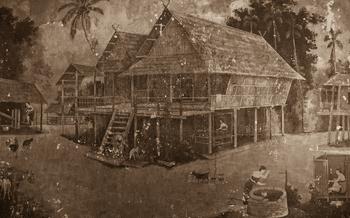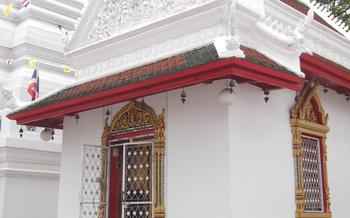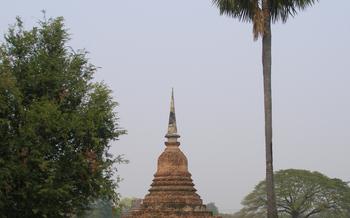
Wat Li
- Wat Li: A Serene Retreat
- Exploring the Temple Grounds
- The Ordination Hall
- The Buddha Image
- The Stupa
- The Bell Tower
- The Monks' Quarters
- The Temple Fair
- Local Handicrafts
- Off-the-Beaten-Path Experiences
- Local Cuisine
- Pilgrimage and Spiritual Practices
- Ethical and Sustainable Tourism
Wat Li: A Serene Retreat
Wat Li stands as a testament to the enduring spirit of Buddhism in Thailand, its history deeply intertwined with the local community. Constructed in the 15th century, the temple has undergone several renovations and expansions, each contributing to its architectural grandeur and religious significance. Revered by devotees for its serene atmosphere, Wat Li offers a sanctuary for spiritual contemplation and a glimpse into the rich cultural heritage of Phayao.
Architectural Features and Unique Characteristics:
Wat Li's architectural design showcases a harmonious blend of traditional Lanna and contemporary elements. The temple's main sanctuary, adorned with intricate carvings and vibrant murals, exudes an aura of tranquility. Its distinctive tiered roof, a hallmark of Lanna architecture, symbolizes the ascending levels of spiritual attainment. Surrounding the sanctuary are numerous stupas, each representing a significant event or figure in Buddhist history.
Religious and Cultural Importance to the Local Community:
Wat Li holds a profound religious and cultural significance for the people of Phayao. It serves as a spiritual center, where devotees gather for prayers, meditation, and religious ceremonies. The temple also plays a crucial role in preserving and promoting local traditions, hosting annual festivals and events that celebrate Phayao's rich cultural heritage.
Practical Information for Visitors:
To ensure a respectful and fulfilling visit to Wat Li, visitors are advised to follow certain guidelines. Appropriate attire is required, with shoulders and knees covered. Photography is permitted, but visitors should be mindful of the sacred nature of the temple and avoid disturbing worshippers. Admission to the temple is free, and visitors are welcome to make donations to support its upkeep.
Exploring the Temple Grounds
The temple complex of Wat Li unfolds like a serene tapestry of religious and cultural treasures. As you traverse its grounds, you'll encounter a layout that exudes harmony and symmetry. The temple's heart, the ordination hall, stands majestically, radiating an aura of sanctity. Notable Buddha images and other religious artifacts are enshrined within the hallowed halls, each possessing a unique story and significance.
Murals, sculptures, and other artistic masterpieces adorn the temple's walls, showcasing the exquisite craftsmanship of local artisans. These intricate artworks depict tales from Buddhist mythology and folklore, inviting visitors to delve into the rich cultural heritage of Phayao. The temple's peaceful atmosphere envelops you, providing an ideal setting for quiet contemplation and reflection.
Take a moment to pause and absorb the serene beauty of Wat Li. Let the tranquility of the surroundings wash over you as you explore its sacred spaces. Embrace the opportunity to connect with your inner self and find solace amidst the temple's spiritual aura.
The Ordination Hall
The ordination hall, or sim, is the most significant building within the Wat Li temple complex. Its architectural design is characterized by a tall, tiered roof, intricate carvings, and symbolic features that reflect Buddhist cosmology. The ordination hall serves as the venue for one of the most important rituals in Buddhism: the ordination ceremony.
During an ordination ceremony, young men formally renounce their worldly lives to become Buddhist monks. The ceremony involves several symbolic acts, including shaving the head, donning saffron robes, and receiving the Three Jewels: the Buddha, the Dharma (teachings), and the Sangha (community).
At Wat Li, ordinations are conducted by senior monks who guide and support the candidates throughout the process. The ceremony is a solemn and sacred occasion, witnessed by family members, friends, and fellow practitioners. For the newly ordained monks, it marks the beginning of their journey on the path of spiritual enlightenment.
Personal anecdotes or stories related to ordinations:
-
I once witnessed an ordination ceremony at Wat Li and was deeply moved by the sincerity and determination of the young men who were taking this significant step in their lives.
-
A close friend of mine ordained as a monk at Wat Li several years ago. It was a profound experience for him and for our entire community.
-
During my travels in Thailand, I have had the opportunity to speak with several monks who shared their personal stories of ordination and their subsequent journeys as Buddhist practitioners.
The Buddha Image
At the heart of Wat Li's spiritual significance lies a revered Buddha image known as Phra Chao Thong Thip. Enshrined within the ordination hall, this awe-inspiring image exudes an aura of serenity and devotion. Crafted from a single block of white marble, it stands tall, radiating an ethereal glow that captivates visitors.
The Buddha image, believed to date back to the 15th century, is a testament to the artistry and craftsmanship of its creators. Its intricate features and graceful posture reflect the essence of Buddhist iconography. The serene expression on the Buddha's face, coupled with the intricate detailing of his robes, evokes a sense of tranquility and inner peace.
Legends and folklore surround Phra Chao Thong Thip, adding to its allure. It is said that the image was created by a renowned monk who possessed supernatural powers. According to local tales, the monk meditated for seven days and seven nights, channeling his spiritual energy into the creation of this sacred masterpiece.
Devotees flock to Wat Li to pay homage to Phra Chao Thong Thip, seeking blessings and guidance. They offer flowers, light candles, and chant prayers, seeking solace and inspiration from this revered image. The Buddha image serves as a reminder of the Buddha's teachings, emphasizing the importance of compassion, wisdom, and the pursuit of enlightenment.
The Stupa
The stupa at Wat Li stands as a testament to the temple's rich history and religious significance. Built in the traditional Thai style, the stupa exudes an aura of serenity and reverence. Its graceful bell-shaped dome, adorned with intricate carvings and colorful tiles, rises majestically towards the sky.
Inside the stupa, a chamber enshrines sacred relics and precious objects, including Buddha images, scriptures, and offerings from devotees. These relics are believed to possess spiritual power and are revered by Buddhists as symbols of the Buddha's teachings.
Throughout the year, religious ceremonies and rituals are held at the stupa, attracting both local and international pilgrims. During these events, monks chant sutras, offer prayers, and perform blessings, creating a deeply spiritual and moving atmosphere.
I had the privilege of witnessing one such ceremony during my visit to Wat Li. As the monks recited sacred texts in a harmonious chorus, the air crackled with an energy that was both palpable and profound. The sight of devotees prostrating themselves before the stupa, their faces filled with devotion, was a testament to the enduring power of faith.
The Bell Tower
At the heart of Wat Li stands the bell tower, a majestic structure that echoes with the sounds of devotion and spirituality. Constructed with intricate craftsmanship, the bell tower is a testament to the temple's rich history and architectural prowess. Its design features multiple tiers, each adorned with delicate carvings and intricate motifs, symbolizing the ascent towards enlightenment.
Bells, in Buddhist tradition, hold a profound significance. Their melodious chimes serve as a call to prayer, summoning the faithful to gather for religious ceremonies and meditation sessions. The act of ringing the bells is believed to purify the mind, dispel negative energy, and create a harmonious atmosphere within the temple grounds.
During temple festivals and special occasions, the bell tower comes alive with the rhythmic sounds of bells, filling the air with a symphony of devotion. Devotees line up to take turns ringing the bells, offering prayers and blessings for themselves and their loved ones. The reverberating sounds reverberate through the temple complex, creating a sense of tranquility and serenity that envelops all who hear them.
Whether you choose to ring the bells yourself or simply stand in awe of their majestic presence, the bell tower at Wat Li offers a unique experience that connects you with the spiritual essence of the temple. Let the harmonious chimes wash away your worries and immerse yourself in the sacred atmosphere that surrounds this architectural masterpiece.
The Monks' Quarters
At Wat Li, the monks' quarters offer a glimpse into the daily lives of the Buddhist monks who reside within the temple complex. These quarters are typically simple and modest, reflecting the monks' commitment to a life of simplicity and detachment. The architecture of the quarters often features traditional Thai designs, with wooden structures and tiled roofs.
Within the monks' quarters, the monks engage in their daily routines, which include meditation, chanting, and alms-giving. Visitors may have the opportunity to observe these rituals and gain insights into the monastic lifestyle. It is important to be respectful of the monks' privacy and to follow any guidelines or rules posted in the quarters.
Interactions with the monks can be a rewarding experience for visitors, as the monks are often willing to share their knowledge and insights about Buddhism and Thai culture. Visitors may have the chance to ask questions, learn about the monks' daily lives, and gain a deeper understanding of the Buddhist faith.
For those interested in a more immersive experience, it is possible to arrange a stay at the temple, where visitors can live alongside the monks and participate in their daily activities. This can be a unique opportunity to learn about Buddhism firsthand and to experience the tranquility and peace of the temple environment.
The Temple Fair
Every year, Wat Li comes alive with the vibrant energy of its annual temple fair. This grand celebration, held during the dry season, attracts devotees, locals, and tourists alike to partake in the festivities and pay homage to the temple.
The fairgrounds buzz with excitement as vendors set up stalls offering a delectable array of local delicacies, from savory grilled meats to sweet sticky rice desserts. The air fills with the aroma of traditional Thai cuisine, enticing visitors to indulge in culinary delights.
In addition to food stalls, the fair showcases the region's rich cultural heritage through traditional performances and displays. Visitors can witness graceful Thai dance troupes, marvel at the intricate costumes and elaborate masks of Khon masked dance, and enjoy lively music performances that fill the air with rhythmic beats.
The temple fair is also an opportunity to purchase unique handicrafts and souvenirs. Local artisans proudly display their creations, including intricate textiles, hand-painted pottery, and skillfully carved wooden figurines. These beautiful items not only serve as mementos of the temple visit but also support the local economy and preserve traditional craftsmanship.
As the sun begins to set, the temple fair culminates in a spectacular fireworks display that illuminates the night sky with vibrant colors and dazzling patterns. This grand finale symbolizes the end of the festivities and leaves visitors with a sense of joy, wonder, and a lasting memory of their experience at Wat Li.
Local Handicrafts
The Phayao region is home to skilled artisans and craftsmen who create beautiful handicrafts using traditional techniques and materials. These artisans often work from their homes or small workshops, and their products are sold at local markets, fairs, and shops.
One of the most popular local handicrafts is textiles. The Phayao region is known for its production of high-quality cotton and silk, which are used to create a variety of textiles, including clothing, blankets, and scarves. The textiles are often decorated with intricate designs and patterns, which are often inspired by nature or local culture.
Another popular local handicraft is pottery. The Phayao region has a long history of pottery making, and the local potters create a variety of beautiful and functional items, such as plates, bowls, vases, and pots. The pottery is often made from local clay and is fired in traditional kilns.
Wood carving is another important local handicraft. The Phayao region is home to a number of skilled wood carvers who create a variety of products, including furniture, sculptures, and decorative items. The wood carvers often use local woods, such as teak and rosewood, and their work is often inspired by Buddhist mythology and culture.
If you are visiting Wat Li, be sure to take some time to explore the local handicrafts. You can find a variety of unique and beautiful products that are perfect for souvenirs or gifts. By purchasing local handicrafts, you can also support the local economy and help to preserve traditional skills and techniques.
Off-the-Beaten-Path Experiences
Beyond the main tourist attractions, Phayao offers a wealth of hidden gems and lesser-known experiences for those willing to venture off the beaten path. Explore the tranquil Wat Jong Kham, a serene temple nestled amidst lush greenery, or discover the enchanting Wat Sri Don Chai, renowned for its stunning murals and intricate carvings. Immerse yourself in the natural beauty of the Phayao Lake, where you can take a leisurely boat ride, marvel at the majestic mountains, or simply relax on the shores. For a unique cultural experience, visit the nearby Ban Thung Kwian Village, where you can witness the traditional lifestyle of the Tai Lue people and learn about their ancient customs. Whether you're seeking tranquility, adventure, or cultural immersion, Phayao has something to offer every traveler.
Insider Tip: Don't miss the opportunity to visit the Phayao Night Market, a vibrant hub of local life where you can sample delicious street food, browse unique handicrafts, and experience the infectious energy of this charming town.
Local Cuisine
Phayao's cuisine is a delightful blend of traditional Thai flavors and unique local ingredients. Among the must-try dishes is khao soi, a flavorful curry noodle soup made with coconut milk, northern Thai spices, and tender chicken or beef. Sautéed fiddlehead ferns with garlic and oyster sauce offer a taste of the region's natural bounty. For a refreshing treat, indulge in khao lam, a sweet sticky rice dessert cooked in bamboo.
When visiting Wat Li, don't miss the opportunity to sample the local street food. Vendors near the temple offer mouthwatering snacks like sai ua, a flavorful northern Thai sausage, and khanom jeen nam ngiao, a rice noodle dish served with a spicy tomato-based sauce.
Recommended Restaurants:
-
Khao Soi Mae Sai: A local favorite known for its delicious khao soi.
-
Ruan Rim Nam: Offers stunning views of the lake and serves authentic Phayao cuisine.
-
Je T'aime Pâtisserie: A charming café serving French pastries with a Thai twist.
Dining Etiquette:
-
Use a spoon and fork or chopsticks when eating.
-
Avoid pointing your feet at the Buddha image or other sacred objects.
-
When dining with monks, let them start eating first as a sign of respect.
Pilgrimage and Spiritual Practices
Wat Li holds a special significance as a pilgrimage site for devout Buddhists and spiritual seekers from around the world. The serene atmosphere and sacred spaces within the temple provide an ideal setting for introspection, meditation, and spiritual practices. Visitors can participate in meditation retreats, chanting sessions, and other spiritual activities led by experienced monks and practitioners. These programs offer an opportunity for personal growth, self-discovery, and a deeper understanding of Buddhist teachings. Whether you're a seasoned meditator or seeking a new spiritual experience, Wat Li offers a sanctuary for reflection and inner peace. Embrace the opportunity to learn from the wisdom of the monks, connect with your inner self, and embark on a transformative journey of spiritual exploration.
Ethical and Sustainable Tourism
As a responsible traveler, it's essential to practice ethical and sustainable tourism at Wat Li. Here are some tips to minimize your environmental impact and support the local community:
-
Respect the Temple Environment: Remove your shoes before entering the temple grounds, and dress modestly to show respect for the sacred space.
-
Support Local Businesses: Opt for local restaurants and guesthouses over large chains to directly support the community. This can help preserve Phayao's unique culinary traditions.
-
Reduce Plastic Waste: Bring your refillable water bottle and avoid single-use plastics. Many temples provide water refill stations, so take advantage of them.
-
Respect Cultural Customs: Be mindful of local customs and traditions. For example, avoid pointing your feet towards Buddha images and always ask permission before taking photographs of people or religious objects.
-
Give Back: Consider making a donation to the temple or participating in volunteer activities that support the local community. This can be a meaningful way to give back to the people who have welcomed you into their sacred space.




